GoWin R86S-N Performance
The Intel Core i3-N305 is a CPU that we absolutely love. We have called this one of the biggest generational leaps in CPUs that we have seen recently, as it moved the entire line from almost a decade of quad-core E-core parts to an 8-core part.
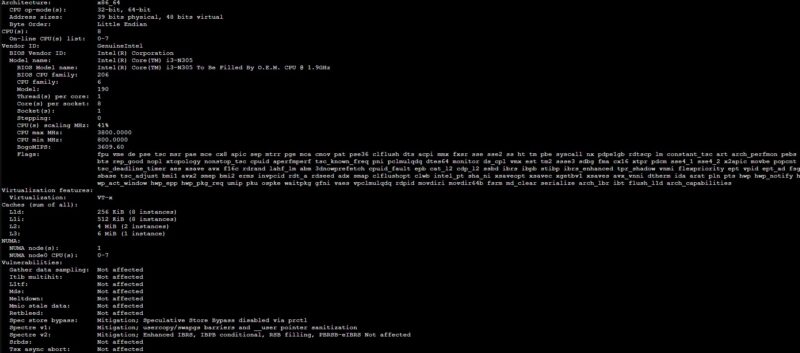
This part also has features like a 9th PCIe Gen3 lane that helps in I/O-focused systems like this.
Since we have seen the N305 many times, we just wanted to confirm that we are getting the expected performance.
Python Linux 4.4.2 Kernel Compile Benchmark
This is one of the most requested benchmarks for STH over the past few years. The task was simple: we have a standard configuration file, the Linux 4.4.2 kernel from kernel.org, and make the standard auto-generated configuration utilizing every thread in the system. We are expressing results in terms of compiles per hour to make the results easier to read:
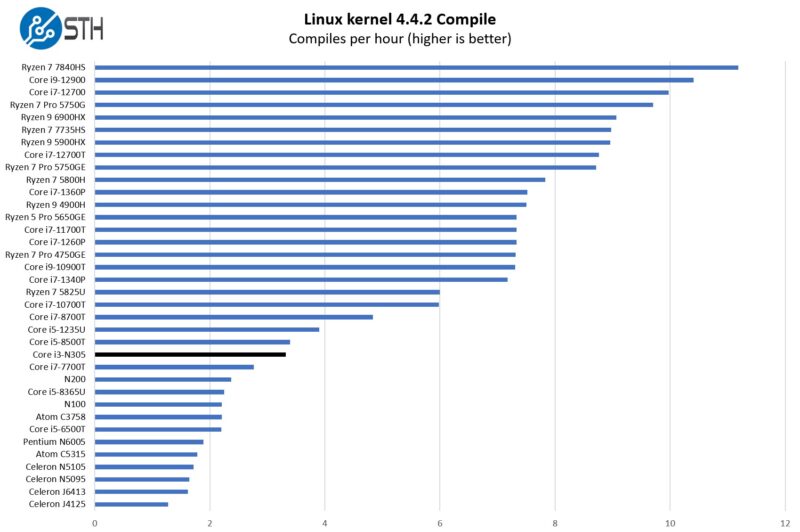
Overall, this is about what we would expect from the system. Performance well beyond the Intel Atom C3758 and the Atom C5315 and closer to what we see on the TinyMiniMicro side around the 8th Gen Core i5 level of performance.
7-zip Compression Performance
7-zip is a widely used compression/ decompression program that works cross-platform. We started using the program during our early days with Windows testing. It is now part of Linux-Bench.
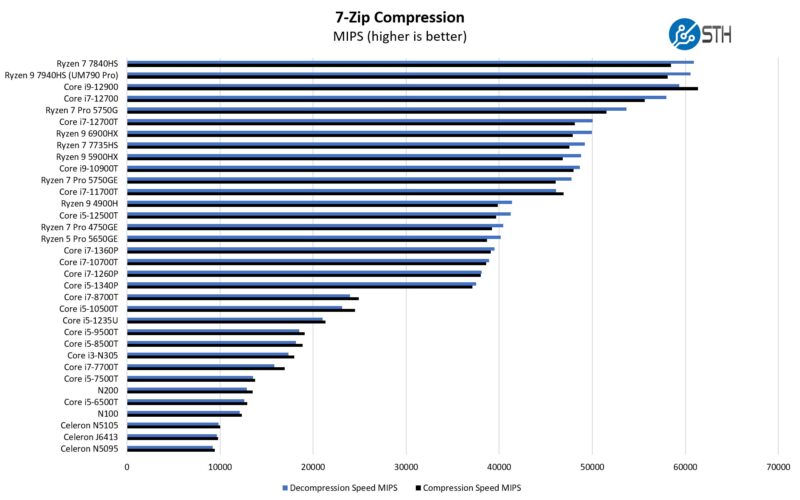
The 7zip results were similar to what we have seen before.
OpenSSL Performance
OpenSSL is widely used to secure communications between servers. This is an important protocol in many server stacks. We first look at our sign tests:
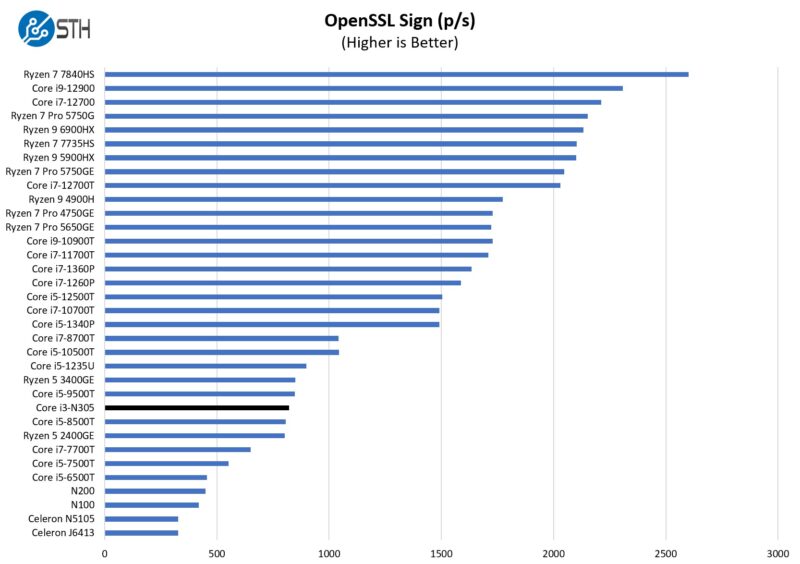
Here are the verify results:
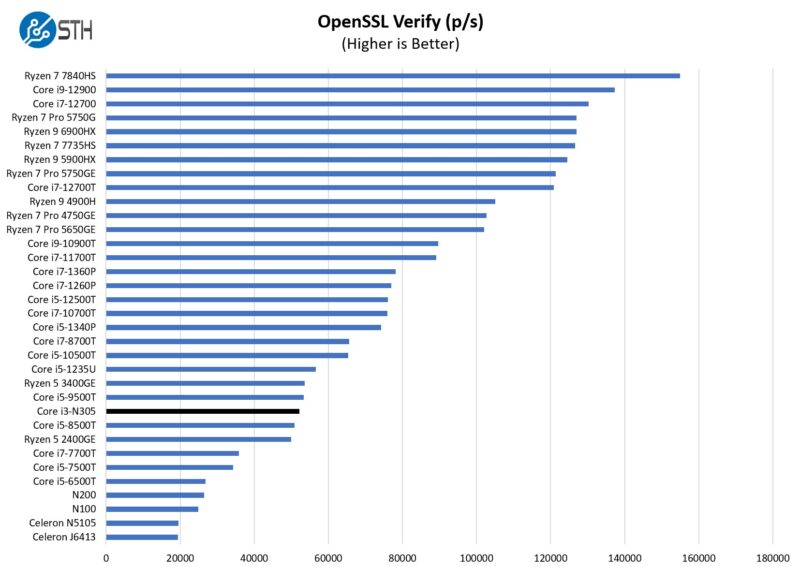
Likewise, the N305 performed similarly to the N305. While we did not have the lower-end N100 version of the R86S-N, our sense is that the CPU performance would align with what we are showing here for the N100.
GoWin R86S-N Networking
We were using Debian/ Proxmox VE for network testing. The 2.5GbE ports one can hammer on this system because the N305 is way too fast to be a bottleneck for those.
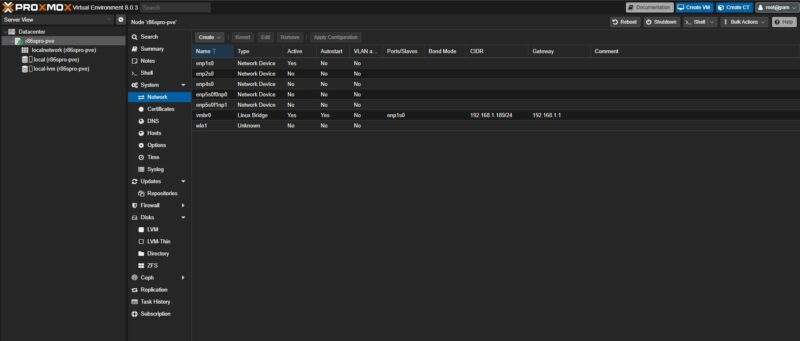
On the NVIDIA ConnectX-4 Lx NICs, we were topping out around 20Gbps, but we did not tune for the full CX4 tuning guide parameters, so there might have been more there. It is right to think about this having more performance than 10GbE, but we would not expect dual 25Gbps links running at full speed.
If this seems a bit strange, remember that the N305 has competitive performance with something like an Intel Xeon E5-2670, so there is enough power to run well beyond 2.5GbE speeds.
On the subject of power, let us get to that next.




Can the 25gbe SFP+ ports negotiate and run at other speeds like 10gbe, 5gbe, 2.5gbe, or 1gbe?
Hot damn. These would be perfect here in Switzerland. Init7, a local ISP, will give you 25Gbps FTTH as a one-off upgrade, no change to monthly costs. The main obstacle is the cost of equipment to handle 25Gbps but these boxes look perfect.
It cannot fully exploit the 25 Gb interfaces and it is CPU-wise far inferior to most other options. I have to ask what is the point? Interfaces on the front _and_ the side. The layout is not optimal.
Once upon a time there was a Raspberry Pi with 1 Gbps Ethernet connected through USB 2. The resulting packet loss conspired with Internet latency and switches with no flow control for throughput that ended up below 100 Mbps.
In my opinion any system that can’t receive packets at wire speed (whatever that speed may be) is likely to experience similar problems.
@emerth Totally agree. These are being revered by STH and a small almost religious following for the cuteness factor alone. Fans that are non standard and CPU that are underpowered for the NIC interfaces and in small formfactor for the cuteness factor alone.
x86S team needs to rethink the design, it needs standard replacable fans as a minimum also larger footprint, but then it will look like any of the other 117 other options on the market, maybe the 10gig or 25gig interfaces being the only distinguishing attribute.
I would like to know if you could disable unneeded chips like sfp+ ports. they are definitely useful but I expect most would want this as future proofing but as most have 1gbit internet or slower right now, leaving those sfp+ chips idling would be chewing 5 watts. Similarly, many wont be using wifi chips so wont need it inbuilt.
Nigel – You can use the NVMe bottom and remove the NIC completely.
Lance – I guess my question is whether you have used the R86S original or the new N305 one reviewed here? As someone who has personally used over 117 different mini PCs/ 1L PCs in the last three years (there are ones we never reviewed as well) you are right my team and I like the R86S and this new version. We bought more R86S’s and we use them all the time.
It’s R86S-N305C
there’s a reference to a potential 1U, anymore info on that?
John – I think it is launching this month and we are getting one, the early sample has not arrived yet.
Any idea whether that short M.2 slot on the alternate bottom supports 2230 sized storage (like in the Steam Deck) vs. only wi-fi? I’d love to use that for the boot drive for proxmox/truenas and pass-through the other 3 m.2 slots I’d have in that configuration for a zfs pool.
Oh man, with the Mellanox Connect-4 Lx board this looks perfect for what I want it for. Only interested in 10 Gbps operation with the SFP28 ports.
They have the version with a CX-4 Lx up on AliExpress now, but at quite a premium.
I’m not really sure what the purpose of these devices are. Are they for network routing? If so how do you rackmount them when some of the sockets are on the side, or access the button on top? Perhaps they are only meant to sit singly on a desk? If so, it will look a bit messy with all the cables sticking out in every direction. Are they meant for outdoor use with WiFi links? If so do they have suitable outdoor enclosures?
Compare this to say MikroTik, who have router designed products that can be stacked in a 2×2 configuration and rack mounted in a 1U space, with all sockets accessible on the front and back. They have outdoor products too that ship already in waterproof enclosures. They also have products aimed for desktop use with all the sockets on the back so that cables neatly flow down behind a desk reducing clutter.
It’s clear to me where each MikroTik product is targeted, but with something like this I’m not really sure what they are targeting, and the design seems to have too many compromises to make it practical in any particular environment.
It seems like the only use case is for the ultra budget conscious where practicality and tidiness take a back seat to cost. But then someone in that position seems unlikely to spring for 25 GbE gear so the Raspberry Pi seems more suitable for that market segment.
Unfortunately it is not in stock.
I am trying to recommend some systems for few friends that need small 25G router with few 2.5G ports and WiFi, and this is absolutely perfect in form factor and functionality. In fact there is nothing else like this.
(At home I have a bigger custom 25G router in 2U case; but some of my friends and clients, want something smaller and less ports)
The issue is probably that at full 25G it will be bottlenecked by CPU and thermals, so I understand it is not perfect. I am still searching for something small, and capable of 25G routing (IPv4, IPv6, with IPv4 NAT and few very simple port forwardings, not much more, probably running VyOS, or similar).
PS. servethehome rejects plus sign in my email address, despite it being totally valid address.